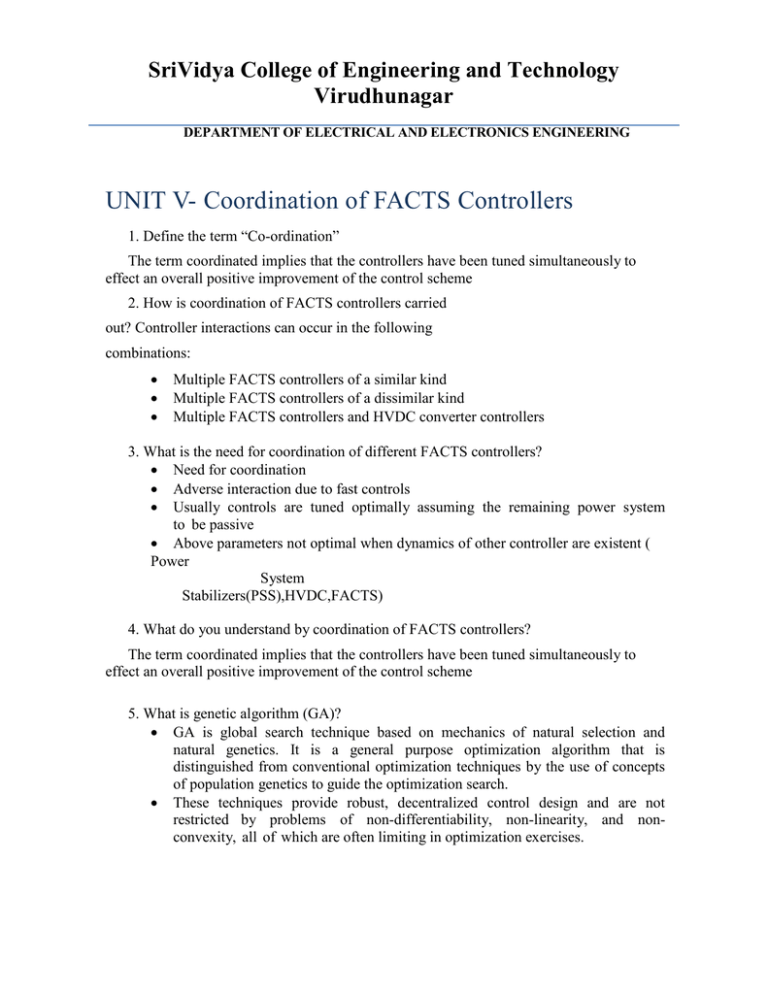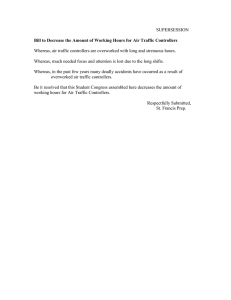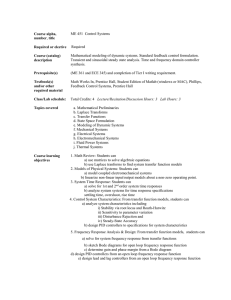UNIT V- Coordination of FACTS Controllers
advertisement

WWW.VIDYARTHIPLUS.COM SriVidya College of Engineering and Technology Virudhunagar DEPARTMENT OF ELECTRICAL AND ELECTRONICS ENGINEERING UNIT V- Coordination of FACTS Controllers 1. Define the term “Co-ordination” The term coordinated implies that the controllers have been tuned simultaneously to effect an overall positive improvement of the control scheme 2. How is coordination of FACTS controllers carried out? Controller interactions can occur in the following combinations: Multiple FACTS controllers of a similar kind Multiple FACTS controllers of a dissimilar kind Multiple FACTS controllers and HVDC converter controllers 3. What is the need for coordination of different FACTS controllers? Need for coordination Adverse interaction due to fast controls Usually controls are tuned optimally assuming the remaining power system to be passive Above parameters not optimal when dynamics of other controller are existent ( Power System Stabilizers(PSS),HVDC,FACTS) 4. What do you understand by coordination of FACTS controllers? The term coordinated implies that the controllers have been tuned simultaneously to effect an overall positive improvement of the control scheme 5. What is genetic algorithm (GA)? GA is global search technique based on mechanics of natural selection and natural genetics. It is a general purpose optimization algorithm that is distinguished from conventional optimization techniques by the use of concepts of population genetics to guide the optimization search. These techniques provide robust, decentralized control design and are not restricted by problems of non-differentiability, non-linearity, and nonconvexity, all of which are often limiting in optimization exercises. WWW.VIDYARTHIPLUS.COM V+ TEAM WWW.VIDYARTHIPLUS.COM 6. List the advantages of genetic algorithm. An advantage of genetic algorithm techniques is that the parameter limits can be varied during the optimization, making the techniques computationally efficient. 7. List the possible combination of FACTS controller interactions. Multiple FACTS controllers of a similar kind Multiple FACTS controllers of a dissimilar kind Multiple FACTS controllers and HVDC converter controllers 8. Give The frequency range of the different control interactions 0 Hz for steady state interactions 0-3Hz for electromechanical oscillations 2-15Hz for small signal or control oscillations >15 Hz sub synchronous resonance interactions >15 Hz for electromagnetic transient high frequency resonance or harmonic resonance interactions, and network resonance interactions 9. What are the basics procedures of the controller design? Derivation of the system model Enumeration of the system performance specifications Selection of the measurement and control signals Coordination of the controller design Validation of the design performance evaluation 10. Write the assumptions of control coordination for damping enhancement? All controllers in the system including FACTS have the transfer function of the type kjGj (S) The component Gj(S) in the transfer function is responsible for causing the left shift in the electromechanical mode The gain Kj in the transfer function decides the magnitude of left shift in the mode of interest 16 MARKS 1. Using linear control techniques, explain the co-ordination of multiple controllers. 2. Explain the controller interactions between multiple SVCs (SVC-SVC) in a large power system. WWW.VIDYARTHIPLUS.COM V+ TEAM WWW.VIDYARTHIPLUS.COM 3. Explain the FACTS controller interactions with similar, dissimilar HVDC controller links. 4. Describe the genetic algorithm based control co-ordination of FACTS controllers. 5. Explain the co-ordination of multiple controllers using genetic algorithm. WWW.VIDYARTHIPLUS.COM V+ TEAM



